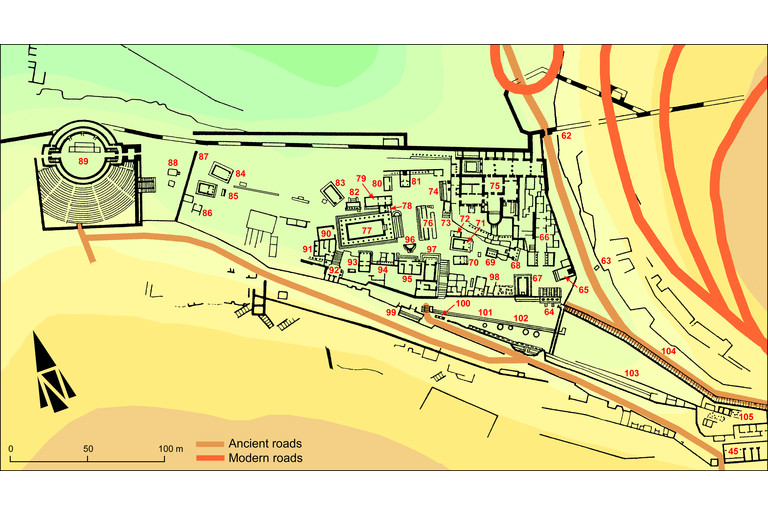Probably honors
GVCyr057
Trismegistos ID: 738946
Source Description
Repository
Cyrene Museum, 543 + 570 + 591.
Support
Three fragments of a white marble oblong block: fragment a, broken off on all sides but on the right (0.155; 0.10;0.085); fragment b, broken off on all sides (0.125; 0.075;0.075); fragment c, broken off at right, on top and at left and chipped off below, but preserving probably the original lower face (0.44; 0.13;0.18). As photographed, fragments b and c seem to have been partly adjacent.
Layout
Inscribed on one face in at least three lines (on fragment c the inscribed surface has dimensions 0.27; 0.05;).
Letters
Average 0.015, letters well cut and pressed together: alpha with dropped bar, beta with larger lower loop, low delta with protruding right stroke, kappa with long oblique bars, pi with equal hastae, non-slanting sigma, phi with very tall hasta, horseshoe omega.
Place of Origin
Findspot.
Date
Second to third centuries A.D. (lettering)
Findspot
Found before 1930 at Cyrene pleiades; HGL : fragments b and c photographed in 1930 as from the Sanctuary of Apollo ; findspot unrecorded for fragment a.
Last recorded Location
All three fragments seen by C. Dobias-Lalou in 1977 (and again in 2001 for fragment a) at Shahat : Cyrene Museum
Text constituted from
Transcription from stone (CDL) with help from J.M. Reynolds' copy.
Bibliography
Not previously published.
Text
Apparatus
1 δίς σο[ι] : δίσσο[ι] (also possible)
French translation
[---] deux fois pour toi [---] porter la couronne sacrée [---] [---] et les [---] ; [---] moi, la bonne année, je suis venue toucher (ta) maison.
English translation
[---] twice for you [---] to wear the sacred crown [---] [---] and the [---] ; [---] I, the good year, I came upon (your) house.
Italian translation
[---] due volte per te [---] portare la corona sacra [---] [---] e [---] ; [---] io, il buon anno, sono giunto alla (tua) casa.
Commentary
Fragments b and c may be seen joined together on an ancient archive photograph. It is J.M. Reynolds' credit to have suspected that all three fragments, which bear different inventory numbers and were observed separately by C. Dobias-Lalou, belong to the same stone.
J.M. Reynolds described the larger fragment (c) as from a moulded base. This seems the more puzzling that she also pointed out (as C. Dobias-Lalou did) that the inscribed face was only roughly dressed. The inscription was thus probably cut on a re-used block of which the opposite side is now lost.
The placement of loose fragment a is proposed without certainty on behalf of the iunctura στέμμα φέρειν, which would be a poetical equivalent of στεφανοφορέω, refering to a magistrate 'wearing a crown', most probably a priest.
The word λυκάβας used at the nominative as the subject of a 1st person verb at line 3, puzzling as it is, might develop the idea expressed elsewhere through the adjective καλλιέτης for an eponym priest whose year was successfull (see IRCyr C.223 l. 5, IRCyr C.224, IRCyr C.251, IRCyr C.336). If so, the οἶκος upon which this 'good year' occurred might be either Apollo's temple or a family house, the latter connected possibly with δίς σοι at line 1: the same family would have produced two priests 'of the good year'. However, the context is so lacunar that all this remains a pure hypothesis.
Line 3 is the most lacunar of all. The segment at the beginning might be read in several different manners. The τε at the end leads to suppose that another word at the accusative plural followed by another τε preceded the uncomplete word endign with ρους.
Metrical analysis: the small fragments offer a dactylic rhythm. Only at line 4 is a whole verse restorable and it would be a pentameter. However, as there is a leaf at the end of the preserved segment of line 3, we cannot know whether this marks the end of a verse or the end of a sentence inside a verse. We thus cannot be sure that the whole poem was made of elegiac couplets.
Creative Commons Attributions-NonCommercial 4.0 International License.
All citation, reuse or distribution of this work must contain a link back to DOI: http://doi.org/10.6092/UNIBO/IGCYRGVCYR and the filename (IGCyr000000 or GVCyr000), as well as the year of consultation.
